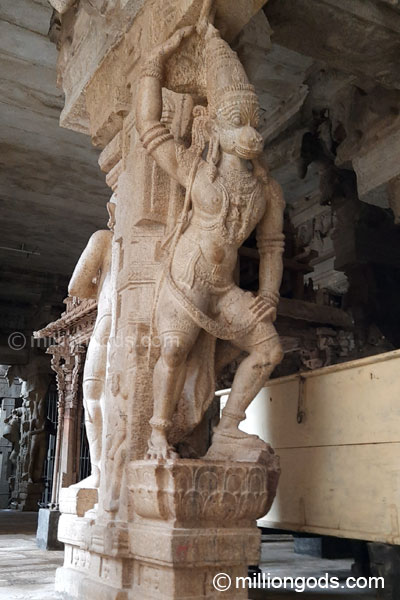Nindra Nambi, facing east
Thirukurungudi

God
Goddess
Kurungudi Nachiyar, facing east
Other Deities
Irundha Nambi, Kidandha Nambi, Aandal, Mahendragirinadar, Kalabhairava, Azhwars, Navaneethakrishna, Manavala Mamuni, Lakshmi Narasimhar, Gnanapiran, Kannivinayakar, Dasavataram, Srinivasa Perumal, Garudan
Thirukurungudi is a large east-facing temple with 5 Prakarams. 3 Prakarams are inside the temple. The outermost 2 Prakarams are outside the enclosed compound wall and are streets running around the temple. The streets just outside the wall are the Mada Veedhi and the outermost streets where the Temple Car is stationed forms the Car Street in all 4 directions around the temple. Thirukurungudi temple is entered through a Gopuram which only has a beautiful huge base. This gopuram has several excellently carved depictions of Lord Vishnu and Shiva in various forms. After this is the outer Prakaram. A long Mandapam is present after the gopuram and before the entrance to the inner Prakaram This Mandapam has some excellent carvings and Pillars. The inner Prakaram is entered through a large 5 tiered Rajagopuram. The insides of this gopuram have wooden sculptures. The stone part of the gopuram has some great carvings including a horse and elephant created with women figures, Rama and Lakshmana with Anjaneya, and others. The inner Prakaram is partly covered and at the western side is a Theertham Tank and shrine for Navaneetha Krishna. On the southeast side of this Prakaram are Mandapams with some brilliant carvings which include Narasimha killing Hiranyakashipu, Yaali Pillars, Anjaneya, and others. The innermost Prakaram houses all the Sanctums and the shrines. The main deity is about 18 feet tall. In between the main deity and the shrine of Kidandha Nambi is a shrine for Lord Shiva as Mahendragirinadar.
Holy Water (Theertham) – Thiruparkadal, Pancha Thurai
Sacred Tree (Sthala Vriksham) – Panai (Palmyra Palm – Borassus flabellifer)
Vimaanam – Panchaketa Vimaanam






History
Thirukurungudi temple has inscriptions from the 10th century CE of the Medieval Chola period mentioning grants to the temple in the form of sheep. Another inscription from the 14th century CE during the rule of Sundara Pandya II mentions gifts of 25 cows for the perpetual lighting of ghee lamps in the temple, lands, and other items. The Pillared Mandapams and several other structures were created during the 15th Century by the Nayak Kings. An inscription dated 1059 CE mentions excavation of a channel with dams and further repair works to the dam. There are a couple of damaged and unreadable inscriptions on two pillars. Three copper plate inscriptions dated 1456, 1537, and 1592 CE indicate grants from Sabala Veera Chandra Ramavarma Maharaja, Vittala Raya of Vijayanagar Empire, and Vira Vasantha Venkatadeva Maharaja respectively mentioning several grants to the Thirukurungudi temple. Nammazhwar, Thirumangai Azhwar, Thirumazhisai Azhwar, and Peyazhwar (7th to 11th Century CE) have rendered Mangalasasanam for the Lord here at Thirukurungudi.
Legend
Lord Vishnu in his Varaha Avatar stayed here in a small place along with his consort Mahalakshmi and hence the place was known as Kurungudi (small living space). Also believed is that Lord Vishnu in his Varaha Avatar was huge and he shrank himself to be here. Another belief is that Lord Vishnu in his small form of Vaamana Avatar originated here and thus the place was called Thirukurungudi and also as Vamana Kshetram.
Nambaduvan, a person from the singers’ community (Paanar Caste) living in the nearby Mahendragiri Hill came down to sing the praise of Lord Nambi and have darshan of him. On his way, he was stopped by a Cannibalistic demon (Brahma Rakshasa) who wanted to devour him. Excusing himself by saying that he will come back after darshan of the lord he came to the temple. Standing outside he noticed that the flagstaff was obstructing his view of the Lord. Ignoring it he started singing accompanied by his musical instrument. The Lord made the flagstaff move a bit aside to enable Nambaducan to have his darshan. Delighted he went back to the forests to offer himself to the demon. He was stopped by an old Brahmin and requested not to go. Ignoring this he went inside to keep up his word to the demon. But by now the demon had eaten his fill and was not hungry. Nambaduvan offered a fruit given to him at the temple to the demon. Upon eating it he was relieved from a curse to his original form of a Brahmin.
It is believed that Thirumangai Azhwar spent his last days in Thirukurungudi and the temple is thus to referred to as Dakshina Vaikuntam. Kaisika Nataka, a tradition of worshipping Lord Vishnu through Music, dance, and art is believed to have originated at Thirukkurungudi. There is a belief that people acting in and watching these performances would attain Salvation. Arayar Sevai, another form of worshipping Vishnu is also believed to have originated in Thirukurungudi.
Directions
Thirukurungudi is 46 kilometers southwest of Tirunelveli via Nanguneri and about 50 kilometers from Tirunelveli via Cheranmahadevi and Kalakkad.
Stay and Food
None locally. If you are planning to spend time visiting all the connected temples you will require a whole day and you can inform Mr.Ramanujam who lives just outside the temple and officiates there beforehand on 9360548252 or 7667381632 for simple food and accommodation.
